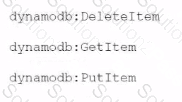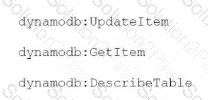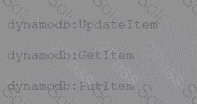DVA-C02 Amazon Web Services AWS Certified Developer - Associate Free Practice Exam Questions (2025 Updated)
Prepare effectively for your Amazon Web Services DVA-C02 AWS Certified Developer - Associate certification with our extensive collection of free, high-quality practice questions. Each question is designed to mirror the actual exam format and objectives, complete with comprehensive answers and detailed explanations. Our materials are regularly updated for 2025, ensuring you have the most current resources to build confidence and succeed on your first attempt.
A developer wants the ability to roll back to a previous version of an AWS Lambda function in the event of errors caused by a new deployment. How can the developer achieve this with MINIMAL impact on users?
A developer wants to expand an application to run in multiple AWS Regions. The developer wants to copy Amazon Machine Images (AMIs) with the latest changes and create a new application stack in the destination Region. According to company requirements, all AMIs must be encrypted in all Regions. However, not all the AMIs that the company uses are encrypted.
How can the developer expand the application to run in the destination Region while meeting the encryption requirement?
A company runs a batch processing application by using AWS Lambda functions and Amazon API Gateway APIs with deployment stages for development, user acceptance testing and production A development team needs to configure the APIs in the deployment stages to connect to third-party service endpoints.
Which solution will meet this requirement?
A developer is receiving HTTP 400: ThrottlingException errors intermittently when calling the Amazon CloudWatch API. When a call fails, no data is retrieved.
What best practice should first be applied to address this issue?
A company is migrating legacy internal applications to AWS. Leadership wants to rewrite the internal employee directory to use native AWS services. A developer needs to create a solution for storing employee contact details and high-resolution photos for use with the new application.
Which solution will enable the search and retrieval of each employee's individual details and high-resolution photos using AWS APIs?
A developer is working on an AWS Lambda function that accesses Amazon DynamoDB. The Lambda function must retrieve an item and update some of its attributes, or create the item if it does not exist. The Lambda function has access to the primary key.
Which IAM permissions should the developer request for the Lambda function to achieve this functionality?
A)

B)

C)

D)

A developer at a company needs to create a small application that makes the same API call once each day at a designated time. The company does not have infrastructure in the AWS Cloud yet, but the company wants to implement this functionality on AWS.
Which solution meets these requirements in the MOST operationally efficient manner?
A company is creating an AWS Step Functions state machine to run a set of tests for an application. The tests need to run when a specific AWS Cloud Formation stack is deployed.
Which combination of steps will meet these requirements? (Select TWO.)
A developer is designing an event-driven architecture. An AWS Lambda function that processes data needs to push processed data to a subset of four consumer Lambda functions. The data must be routed based on the value of one field in the data.
Which solution will meet these requirements with the LEAST operational overhead?
A developer is creating a mobile app that calls a backend service by using an Amazon API Gateway REST API. For integration testing during the development phase, the developer wants to simulate different backend responses without invoking the backend service.
Which solution will meet these requirements with the LEAST operational overhead?
A development team maintains a web application by using a single AWS CloudFormation template. The template defines web servers and an Amazon RDS database. The team uses the Cloud Formation template to deploy the Cloud Formation stack to different environments.
During a recent application deployment, a developer caused the primary development database to be dropped and recreated. The result of this incident was a loss of data. The team needs to avoid accidental database deletion in the future.
Which solutions will meet these requirements? (Choose two.)
A developer has an application that is composed of many different AWS Lambda functions. The Lambda functions all use some of the same dependencies. To avoid security issues the developer is constantly updating the dependencies of all of the Lambda functions. The result is duplicated effort to reach function.
How can the developer keep the dependencies of the Lambda functions up to date with the LEAST additional complexity?
A developer is building an application that uses an Amazon RDS for PostgreSQL database. To meet security requirements, the developer needs to ensure that data is encrypted at rest. The developer must be able to rotate the encryption keys on demand.
A developer is integrating Amazon ElastiCache in an application. The cache will store data from a database. The cached data must populate real-time dashboards. Which caching strategy will meet these requirements?
A developer maintains a serverless application that uses an Amazon API Gateway REST API to invoke an AWS Lambda function by using a non-proxy integration. The Lambda function returns data, which is stored in Amazon DynamoDB.
Several application users begin to receive intermittent errors from the API. The developer examines Amazon CloudWatch Logs for the Lambda function and discovers several ProvisionedThroughputExceededException errors.
The developer needs to resolve the errors and ensure that the errors do not reoccur.
A company is using an AWS Lambda function to process records from an Amazon Kinesis data stream. The company recently observed slow processing of the records. A developer notices that the iterator age metric for the function is increasing and that the Lambda run duration is constantly above normal.
Which actions should the developer take to increase the processing speed? (Choose two.)
An ecommerce startup is preparing for an annual sales event. As the traffic to the company's application increases, the development team wants to be notified when the Amazon EC2 instance's CPU utilization exceeds 80%.
Which solution will meet this requirement?
A developer has created a large AWS Lambda function. Deployment of the function Is failing because of an InvalidParameterValueException error. The error message indicates that the unzipped size of the function exceeds the maximum supported value.
Which actions can the developer take to resolve this error? (Select TWO.)
A developer previously deployed an AWS Lambda function as a .zip package. The developer needs to deploy the Lambda function as a container.
A developer is migrating a containerized application from an on-premises environment to an Amazon ECS cluster.
In the on-premises environment, the container uses a Docker file to store the application. Service dependency configurations such as databases, caches, and storage volumes are stored in a docker-compose.yml file.
Both files are located at the top level of the code base that the developer needs to containerize. When the developer deploys the code to Amazon ECS, the instructions from the Docker file are carried out. However, none of the configurations from docker-compose.yml are applied.
The developer needs to resolve the error and ensure the configurations are applied.
